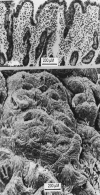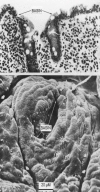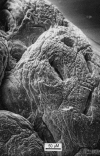Mucosal histopathology in celiac disease: a rebuttal of Oberhuber's sub-division of Marsh III
- PMID: 25926934
- PMCID: PMC4403022
Mucosal histopathology in celiac disease: a rebuttal of Oberhuber's sub-division of Marsh III
Abstract
Individuals with particular genetic backgrounds develop immune responses to wheat proteins and become 'gluten-sensitised'. Mucosal pathology arises through activated mucosal T lymphocytes, resulting in a graded, adverse reaction between particular genes and wheat proteins. Given these varied influences, the Marsh Classification broadly itemises those stages through which a normal mucosa (Marsh 0) evolves in becoming 'flat' (Marsh I, II, III). Recently, Oberhuber and colleagues suggested that Marsh III lesions required subdividing into a, b, c categories. We critically examined these subdivisions by means of correlative light and scanning electron microscopy (SEM). Our results demonstrate that Oberhuber's classification is untenable. In our view deriving from our observations, the artificial subdivisions proposed by those authors actually reflect misinterpretations of the true architectural contours of flat mucosae. Although these workers refer to "villous projections", SEM demonstrates that no such structures are present on flat - or immediately recovering - mucosae. Our data revealed on the surfaces of flat (Marsh III) mucosae, large open "basins", surrounded by raised collars - the latter, when viewed in histological section, being easily misconstrued as "villi". It seems that with subsequent upward growth, these collars coalesce into low ridges, thence becoming broader and higher convolutions. It is noticeable that there are more open spaces on the surfaces of flat mucosae than was appreciated hitherto. We conclude that Oberhuber's revisions of Marsh III into three subcategories (a, b, c), are misinterpretations of the histological appearances of flattened mucosae. Therefore, histopathologists when classifying celiac mucosae, since they add nothing either of diagnostic, nor prognostic, value should resist these subcategories.
Keywords: Marsh III lesion; Marsh celiac classification; Mosaic; Mucosal surface contour; Scanning EM.
Figures






References
-
- Marsh MN. Gluten, major histocompatibility complex, and the small intestine: A molecular and immunobiologic approach to the spectrum of gluten sensitivity (‘celiac sprue’) Gastroenterology. 1992;102:330–54. - PubMed
-
- Marsh MN. Studies of intestinal lymphoid tissue: XIII – Immunopathology of the evolving celiac sprue lesion. Pathol Res Pract. 1989;185:774–77. - PubMed
Publication types
LinkOut - more resources
Full Text Sources
